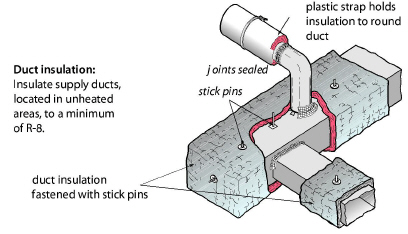
|
SWS Detail: 4.1601.1 Insulating Flex Ducts, 4.1601.2 Insulating Metal Ducts |
Insulate supply ducts that are installed in unconditioned areas outside the thermal boundary such as crawl spaces, attics, and attached garages with vinyl- or foil-faced duct insulation. Don’t insulate ducts that run through conditioned areas unless they cause overheating in winter or condensation in summer. Use these best practices for installing insulation.
✓ Always perform necessary duct sealing before insulating ducts.
✓ Duct-insulation R-value must be ≥R-8.
✓ Insulation should cover all exposed supply ducts, with no significant areas of bare duct left uninsulated.

✓ Insulation’s compressed thickness must be more than 75% of its uncompressed thickness. Don’t compress duct insulation excessively at corner bends.
✓ Fasten insulation using mechanical means such as stick pins, twine, staples, or plastic straps.
✓ Cover the insulation’s joints with tape to stop air convection. However, tape often falls off if the installer expects tape to support the insulation’s weight.
✓ Install the duct insulation 3 inches away from heat-producing devices such as recessed light fixtures.
Caution: Burying ducts in attic insulation is common in some regions and it reduces energy losses from ducts. However, condensation on ducts in humid climates is common during the air-conditioning season, so don’t allow cellulose to touch metal ducts to avoid corrosion from cellulose’s Borate fire retardant.
Important Note: Tape can be effective for covering joints in the insulation to prevent air convection, but the tape fails when expected to resist the force of the insulation’s compression or weight. Outward-clinch staples or plastic straps can help hold the insulation facing and tape together.
8.16.1 Spray Foam Duct Insulation
|
SWS Details: 3.1602.2 Duct Spray Polyurethane Foam (SPF) Installation |
High-density spray foam insulation is also a good duct-insulation option, assuming it is listed as ASTM E-84 or UL 723. Spray foam is particularly helpful in areas where the foam can seal seams and insulate in one application. However, the spray foam application is limited by space around the duct to a greater amount than wrapping with fiberglass blankets.